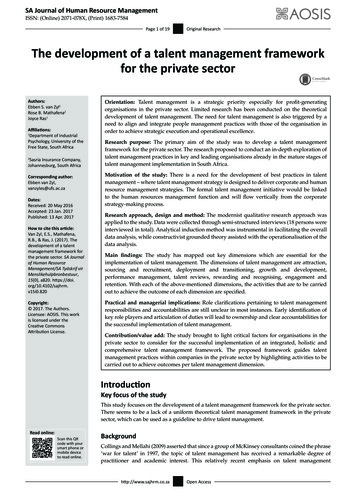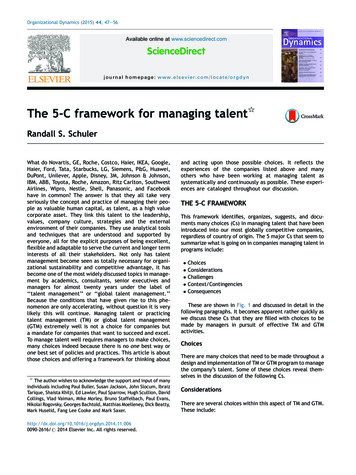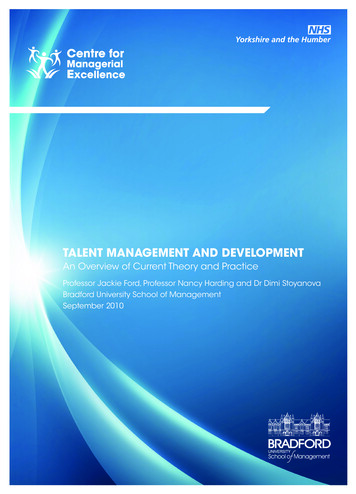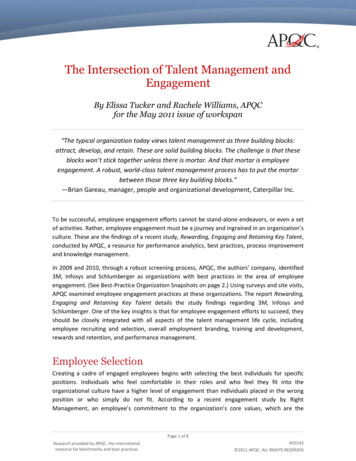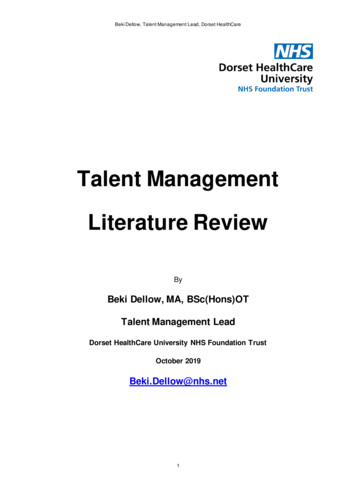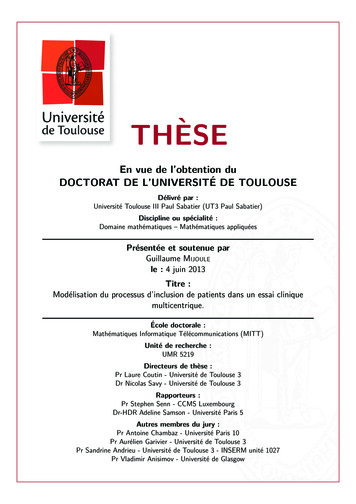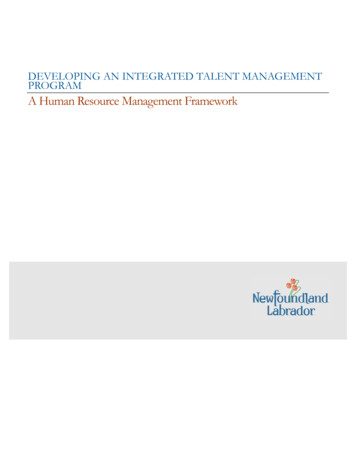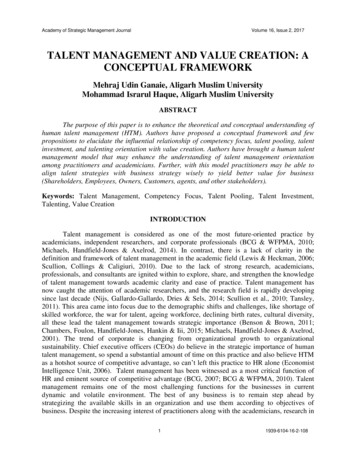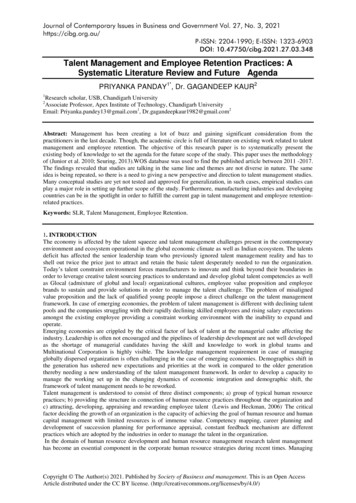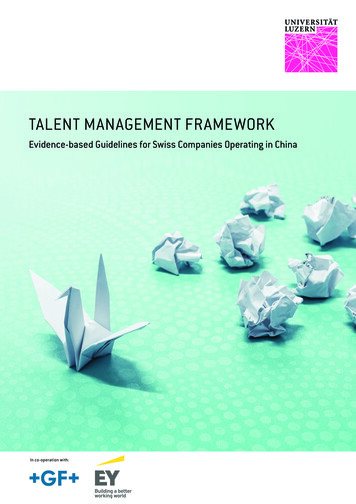
Transcription
TALENT MANAGEMENT FRAMEWORKEvidence-based Guidelines for Swiss Companies Operating in ChinaIn co-operation with:
EditorialDecision makers in multinational Swiss companies dealing with talent management are awareof the versatile cultural environment and its challenges. Starting from a Western talent management perspective, multinational Swiss companies often extend this perspective to a global talentmanagement. However, in their locations around the globe, the subsidiary companies face aspecific challenge by considering local situations. We did research in the Chinese subsidiary ofGeorg Fischer AG to disentangle global and local Chinese talent management issues and to deriveconcrete guidelines for Swiss companies operating in China.This framework is the result of a close and mutually enriching research collaboration betweenthe University of Lucerne and Georg Fischer AG, with the support of EY. With this collaborationand scientific methods we gained insight to answer practical questions such as “Why shouldorganizations do talent management?”, “What are the special local influencing factors in China?”or “What about the negative side-effects on employees who are not in the talent pool?”. Theacademic team of the University of Lucerne conducted interviews in Switzerland and in China,and run data collections in China. Drawing on own research results and on results of the scientificcommunity, we are able to introduce this talent management framework.The innovative result introduced in this framework is a “Talent Management Map”. The TalentManagement Map provides an overview of the complex talent management situation, includingdifferent processes and phases, stakeholders and interests. From this dense network of interactions and dependencies, we choose three paths to explore the cultural influence of China ontalent management and we derive concrete guidelines within these three paths for practitioners.We hope that our research will help to reduce the complexity of global and local talent management and invites you to further explore the talent management map with the three paths exploringthe cultural influence on talent management in China.Prof. Dr. Bruno StaffelbachPeter ZiswilerChristine VogelPresident of the University of LucerneDirector of the Center for HumanResource ManagementHead Corporate HRGeorg Fischer AGEY PartnerPeople Advisory ServicesUniversity of Lucerne, October 20183
Executive SummaryPurpose:The aim of this framework is to challenge and inspire existing talent management in Swiss companies operating in China by: Giving an overview on the complexity of talent management; Exploring the cultural influence of China on talent management; Presenting guidelines on what to consider when doing talent management in China.Method:The content of this framework is based on interviews with 10 Swiss companies and an onlinesurvey with Georg Fischer AG, a Swiss company from the machine-, electrical- and metal industry (MEM) industry, which also has local production sites in China. Furthermore, relevant existing scientific literature completes the framework.Findings: To specifically address Chinese aspects in talent management, a well-structured HR department allows a cultural interface. For example, a Chinese talent manager who is familiar withboth the Western and Asian perspectives can help integrate them both. The conditions for talent management in China and in Switzerland differ. External factors,such as the labor market situation or political decisions, influence the talent managementstrategy and should be considered in the planning phase. Generically formulated identification criteria are interpreted differently in the Chinese culture.Therefore, a specific description rather than generic terms is pivotal. Global identification criteria, such as mobility, need to be specified for China. From a Western perspective, an objective evaluation of performance and potential are pivotal,whereas in China, the focus is on maintaining harmony and mutual benefits among the guanxinetwork. Consequently, the importance of personal relationships, networks, and mobility constraints must be considered when identifying talents. To evaluate an organization’s talent management, key performance indicators (KPIs) that arespecifically interesting for talent management in China must be developed and applied. Cultural specificities, such as mianzi, lead to sensitive situations when discussing employeeperformance, potential, and talent status, which is why careful communication in China is pivotal. Due to cultural concepts, removing talent nominations has significant impact in China andthus must be kept to a minimum.4
Content11.11.2About the Framework.6Talent Management Map.6Three Paths Explored in this Framework.82About the Study.833.13.23.33.43.5Path I: Planning Phase.9Talent Management Strategy.9Benefits of Linking Talent Management and Strategy.10Definition of Talent Management and Talent.11Research Example: From Corporate Strategy to Talent Management Definition.11Guidelines Planning Phase.1344.14.24.34.4Path II: Acting Phase.14Talent Identification.14Opportunities and Challenges of Selected Talent Criteria.15Research Example: Talent Identification Criteria and Chinese Talent Characteristics.17Guidelines Acting Phase.1755.15.25.35.45.55.6Path III: Monitoring Phase.18Talent Management Effectiveness.18Research Example: Internal Development and Promotion Rates and Sub-groups.18Employee Reaction to Talent Management.20Communication and Transparency for Talent Management in China.22Research Example: Ensure Confidential Communication.23Guidelines Monitoring Phase.236Closing Remarks .247Appendix .25References.25Tables and Figures.26Contact.275
1About the FrameworkMany books, articles, and publications deal with the topic of talent management. Although talent management has been a relevant topic for organizations for years, there are still major gapsthat have not been investigated yet. Especially, questions regarding cultural specificities andcultural adaptations of talent management have been excluded from talent management research, leading to a lack of knowledge about organizational practice. Therefore, this frameworkhighlights cultural aspects in talent management. Specifically, the framework focuses on Chinese culture influencing talent management designed from a Western point of view.Talent Management Mapob clj e eafo c t rr T i veM sPath 1Pathdeof finita TM tiole & nnt1This framework does not explore all elements and pathsdisplayed in the map in detail. We choose three specificpaths, which contain core elements of talent management, such as talent management objectives, identification criteria, and evaluation. However, the Talent Management Map provides an orientation and an idea ofthe dimensions of talent management beyond the threepaths explored in this framework.cono sc o f T id es t r p o M i r tira ra n o nte tegyThe Talent Management Map is a summary of the current state of talent management research and serves asframework for orientation in the labyrinth of talent management. The Talent Management Map (see Figure 1.1)structures talent management in three levels, which arecorporate, managerial, and individual, along the sequenceof plan, act, and monitor. Of course, every organization isembedded in a specific context. However, this level is notspecifically represented on the map since the frameworkobviously focuses on the Chinese context. As a decisionmaker regarding talent management questions, the reader might explore the different elements of talent management, the interdependencies between elements, and other influencing factors.NAPLFigure 1.1: Talent Management Map6ta HR inv1.1CONTEXTIn the following, we first introduce the Talent Management Map that summarizes the current stateof research regarding talent management (Section 1.1), and then we explore three paths withinthis Talent Management Map from the Chinese perspective (Chapters 3-5).CORPORATE LEVELWe explored talent management in China and developed guidelines for decision makers in Swisscompanies doing business in China. By presenting the findings and guidelines in this framework,we aim to challenge and inspire existing talent management in organizations.
What do we mean by Talent Management?MONITORore mote t int o nio &npTM erioev diti a l u c a lon a-TMKPIINDIVIDUAL LEVELPa teff Tec Mvon e tio lss v em f d vemian reag c t ener tinACTidencr tificit ae r tiia o nid ten alti e nfic tationde tave lel o ntpmenttprh3al R voen m let m an mea n a g e ntdn ivag r/ o fc o om ererm ita sem tiit o ndeteveelopl pman enMANAGERIAL LEVELWhen referring to talent management in this framework, wethink of key employees (talents) who contribute to the organizational strategic objectives by demonstrating above-averageperformance with high potential. Consequently, we focus onlyon a specific segment of the workforce. Managing talents requires specific structures, processes, and instruments for talent identification, communication, development, and retention. Thus, talent management is a part of general human resource management.7
1.2Three Paths Explored in this FrameworkPlanning Phase (Chapter 3): The first path explores the steps that lead to defining talent. Ideally, talent management is embedded in and supports the organizational strategy. Depending onthe strategy, the organization may define talent management based on the purpose for managing talent (e.g., enabling the development of human resources (HR) or succession planning). Thepurpose of talent management again influences the definition and the policies and practices oftalent management.Acting Phase (Chapter 4): The second path explores the steps included in talent identificationwithin the organization. Building on the talent (management) definition, organizations start looking for employees who fit the talent definition. The identification of talents is based on pre-defined criteria followed by development measures to support talent employees in achieving theset objectives or the target position.Monitoring Phase (Chapter 5): The third path explores methods for evaluating talent management and the influencing factors.2About the StudyThe research findings in this framework are based onthree sources: a qualitative study (interviews), quantitative study (survey), and relevant scientific literature.To conduct the quantitative study and part of the qualitative study, Georg Fischer AG (GF), a Swiss company fromthe MEM industry, which has local production sites in China, provided us access. GF is a multinational organizationheadquartered in Switzerland and employs over 16,000people. It introduced and developed talent managementin the Chinese production sites in the greater Shanghaiarea using a top-down approach. Talent management iscurrently rolled out on the four top employee levels (C-4).Survey methodThe questionnaire contained previously validated questions translated from English toMandarin in a state-of-the-art back translation process. It was distributed via emailprovided by the Georg Fischer’s HR Department. Unique identifiers allowed the research team to match data from questionnaires with objective data obtained directlyfrom the HR Department (e.g., the talentstatus of each employee). All participantswere assured strict confidentiality.We conducted an online survey in GF at the end of 2016 and end of 2017. The response rate in2016 was 60%, and the response rate in 2017 was 76%. The survey sample represented the underlying population of employees well.We conducted interviews with HR managers and business managers in 10 companies, most ofthem from the MEM industry:N 188
3Path I: Planning Phase3.1Talent Management StrategyWhy should organizations do talent management?Demographic change leads to a scarcity of the workforcein many Western countries. Therefore, having talents in theorganization, retaining them, and recruiting new talents, becomes a critical success factor (Festing & Schäfer, 2014).For a meaningful talent management, the organizationalenvironment needs to be considered. Thereby talent management should be defined and developed based on thecorporate strategy and the related objectives for talent management.From our interviews in China we learned that, in Westerncountries, it is a demographic change that leads to a shortage of qualified employees, whereas the manufacturing industry in China faces different labor market issues. First,competition increases from the fintech industry, which attracts a young and well-educatedworkforce by new organizations with interesting jobs and attractive labor conditions. Furthermore, the former attractiveness of foreign multinational organizations has decreased, while theattractiveness of private and state-owned Chinese organizations has increased. Second, dedicated industry zones where many organizations have their offices and production sites nextto each other lead to low barriers for employees to change employers when offered a slightlybetter contract. Third, new governmental regulations have led to changes in the labor market.Due to an increase in the minimum salary in Shanghai, city politics (with a focus on the fintechindustry with the intention to establish them in Shanghai while banning the manufacturing industry from the city area), and new business opportunities, the organizations from the machining and construction industry move away, and the workforce now migrates from East to West.Organizations have diverse reasons to do talent management. In the following section, we introduce four strategic objectives for talent management (Bethke-Langenegger, Mahler, & Staffelbach, 2011).Attraction and retention of talented employees: To attract talents from the internal or externallabor market and retain them, it is important that organizations understand the needs of theemployees and design and promote incentive systems accordingly. It is a global phenomenonthat some years ago employers guaranteed high job security in return for high performance andengagement. However, today, job security is very scarce. Instead, employers offer developmentopportunities and employability in exchange for employee loyalty and engagement (Dries, 2013;Dries, Forrier, De Vos, & Pepermans, 2014).Development of human capital: Developing talents in the process of talent management followsthe objective of qualitatively improving an organizations’ human capital. Development opportunities in an organization satisfy the needs of the talent for career opportunities and advancement.9
Since the economic crises in China in 2016, employees have realized that they cannot rely ontheir employer at all costs (i.e., regarding job security). Together with the changing expectationsof the younger workforce toward the employment situation, this leads to implicit agreements between employees and the organization. Talent management, employee development, and careeropportunities are a currency that organizations offer to gain employee engagement and loyalty(Yi, Ribbens, & Morgan, 2010).Succession planning: If an adequate talent pipeline is missing, it is difficult to fill strategic positions with suitable employees, and organizational growth is limited. Accordingly, an objective oftalent management is to ensure adequate talent succession by having the right number of people with the right skills ready when they are needed.Supporting the organizational strategy: Talent management supports organizations by implementing their strategy. If talent management is recognized as part of the overall strategy and ifan organization-wide talent mindset is established, the employees feel valued and show highermotivation and higher organizational commitment (Gandossy & Kao, 2004).3.2Benefits of Linking Talent Management and StrategyHow can the organization benefit from talentmanagement?Talent management adds the most value tothe organization if it is linked to the organizational strategy. In such situations, talentmanagement influences different businessfactors (see Figure 3.1). For example, aligningtalent management with the corporate strategy has a relevant effect on talents resulting inappreciation, higher motivation, and strongercommitment to the organization (human resource outcomes) (Gandossy & Kao, 2004).Furthermore, organizations report higher financial outcomes (Bethke-Langenegger, 2013),positive influence on organizational attractiveness, achievement of business objectives, and customer satisfaction (organizational outcomes) (Bethke-Langenegger et al.,2011). Therefore, independent of the organizational scope in the local or global markets,organizations need to have a consistentstrategy that is translated into clear talentmanagement.Figure 3.1: How talent management influencesbusiness outcomes (adapted from Bethke-Langeneggeret al., 2011)10
3.3Definition of Talent Management and TalentWho is a talent?Based on the corporate strategy, the organization defines talent management objectives, whichaffect the definition of talent management and the definition of talent. Six different dimensionsneed to be considered, when defining a talent (see Table 3.1). A dimension is conceptualizedas a continuum with extreme opposites at both ends, leading to different implications for talentmanagement policies and practices. While the first four dimensions focus on the individual level,the last two dimensions focus on the corporate level. Dimensions on the corporate level primarily address the question of how the organization can make use of employee’s talents (Cappelli &Keller, 2014; Iles, Chuai, & Preece, 2010).These definitions are not right or wrong. As there is no one-size-fits-all solution for talent management, every organization needs to develop its own perspective and agree on a talent definition during the planning phase, according to the corporate strategy and the objectives of talentmanagement.3.4Research Example: From Corporate Strategy to Talent Management DefinitionGF followed a strict strategy-driven approach to talentmanagement. Talent management is strongly anchored inthe board and was rolled-out from the top. This approachhas the advantage that the managers became involvedand connected with the idea from the beginning. GF communicated talent management very carefully and onlylimitedly.One of the strategic decisions in planning talent management is the communication strategy. Studies show thatonly about one-third of the organizations discuss talentmanagement (King, 2016). From the interviews we conducted in different organizations, we found that the extent and method of communication differs greatly amongorganizations.About half of the interviewed organizations use the intranet to inform their employees about talent management activities. Communication involves the existence ofa talent management program, the criteria for being a talent, information about the process, and the timeline. Furthermore, line managers are involved in talent management so they know the talent status of the employeesand the individual development plans and performanceratings of the employees. Sometimes, employees themselves are involved in creating development plans.“I personally believe that talent management has to be centralized and closelylinked with the corporate strategy. To acknowledge the cultural difference betweenregions, the HR structure needs an intelligent setting. For example, we have someone in the position ‘Regional HR Asia’ whoknows the Asian as well as the Europeanculture. This is important to lead the talentmanagement process in Asia and at thesame time to integrate requirements fromthe Asian culture with the European organizational criteria.”Global head of HR in a global Swiss company inthe MEM industry11
Talent: Individual LevelTable 3.1: Overview of talent (management) definition (adapted from Dries, 2013; Iles et al., 2010)DimensionDescription of the dimensionTM focusObjective –subjectiveObjectiveA persons’ competences lead to talent.Identification and development ofspecific competencies.TM includes competence managementand knowledge management.SubjectiveThe individual is the talent. Identification and development of talentedpeople are crucial.TM includes succession- and careermanagement.InnateTalent is given; it is not possible tolearn it.TM focuses on selection, assessment,and identification of talent.AcquiredTalent can be acquired.TM focuses on education, training,experience, and learning.InputMotivation and engagementcharacterize a talent.TM focuses on motivation, ambition,and career orientation.OutputSuccess characterizes a talent.TM focuses on ability, performance,success, and results.TransferableIndividual shows talent independentof (work) context.TM is transferable across situations.Context dependentTalent is visible only under specificconditions (situations, team constellations).TM is context dependent.InclusiveAll employees considered as talents.The organization would not hiresomeone who does not add value.Same TM for all employees; difficultto differentiate from general good HRmanagement.ExclusiveSpecific workforce segment is labeledas «talents» and receives respectivedevelopment measures.TM for exclusive pool of employeesonly.PositionTalent to be set on key position(i.e., strategically relevant functions).TM is a form of human capital withfocus on key positions.PeopleTalents are key people; only mostpromising talents have access totalent pool.TM focuses on key people, on givinggrowth opportunities, which enableemployees to perform high and todevelop further.Innate –acquiredInput –outputTransferable –context dependentTalent: Corporate LevelInclusive –exclusive12Position –people
The objective of GF was to use talent management for succession planning. Based on the organizational strategy and the talent management objectives of succession planning, talent management was defined. Over time, the wording for the talent definition was adapted and refined,leading to the following talent management definition:“A talent has the potential to move to a position ofhigher complexity/responsibility within 0-3 years.”Georg Fischer AG presentation, 20163.5Guidelines Planning Phase The conditions for talent management in China and Switzerland are not the same. Externalfactors, such as the labor market situation or political decisions, influence the talent management strategy and should be considered in the planning phase. Linking the overall strategy with talent management is pivotal to ensure the involvement ofstakeholders across regions. The definitions of talent and talent management are specific to the organization. Therefore,there is no one-size-fits-all solution, and every organization needs to create its own definitionbased on the talent management strategy and objectives.13
4Path II: Acting Phase4.1Talent IdentificationWhat is the best way to identify a talent?Closely linked to the definition of talent management andtalent is talent identification within the company. The abilityto identify talents is a core issue in talent management andtherefore is also considered the “holy grail” of talent management (Church, 2015). This is probably why identifying talentshas emerged as one of the hottest areas of applied HR research and practice (Church & Rotolo, 2013; Silzer & Church,2009, 2010).PerformanceTalent identification is mostly done by the direct manager(79%, according to a Canadian study; Slan-Jerusalim & Hausdorf, 2007), using the elements “personal experience withthe person” (100%), “performance appraisal” (97%), and “pastperformance and results” (79%; Slan-Jerusalim & Hausdorf,2007). Furthermore, many of our interview partners mentioned using a nine-box grid oftencalled a “talent matrix” to identify talent (Figure 4.1). The grid structures the workforce alongtwo dimensions: performance and potential. This leads to different groups, including talents.However, whereas performance is a sufficiently clear criterion, the potential remains fuzzy. Inthe following section, we show a selection of talent criteria, among them performance and potential, and the Chinese cultural aspects.highRanking isunlikelyHighperformerTalentsmediumChange eperformanceRanking isunlikelylowmediumhighPotentialFigure 4.1: Talent matrix14
4.2Opportunities and Challenges of Selected Talent CriteriaWhat are the special local influencing factors in China?Talent identification criteria are derived from the corporate strategy and thus are unique foreach company. However, certain criteria have generic relevance, for example performance andpotential, whereas others are heavily influenced by culture, for example networking and relationships. In the following section, the opportunities and challenges of five selected criteria arediscussed from a cultural perspective.Performance: Hempel (2001) showed that performance appraisal criteria differ across cultures. Chinese managers appear more likelythan Western managers to base performancereviews upon personal characteristics, suchas loyalty and obedience, than upon reference to outcomes. This difference is essentialsince, from a Western perspective, ratingsbased on personal attributions are one primary source of error in performance rating(Hempel, 2001).An example of how to ensureobjective talent identification:“In our organization, we discuss the performance appraisal in a meeting togetherwith the other divisions’ group leaders. HRbusiness partners moderate the meetings and all leaders put their proposedemployees on the table. The goal is tobe as objective as possible, so that notonly one leader decides for his or herown team. This platform enables us to exchange and share feedback to and experience with specific persons.”Potential: Potential is a higher-order constructand is difficult to measure. Silzer and Church(2009) proposed that potential is a constructmade up of different types of components,such as:HR business partner of a multinational Fundamental components are stable andMEM industry companynot changeable over a lifetime (e.g., personality and cognition). Latent components need the right contextand support to express themselves (e.g.,motivation). Intervening components influence the degree an individual can grow and develop in differentareas (e.g., openness to feedback). Evolving components are acquired by an individual through career experience (e.g., technicalknowledge).Each organization defines its own potential criteria. Clearly defined and practically described criteria help managers evaluate employee potential. For example, asking for leadership competencies is less valuable than asking the manager if the employee would be able to lead a team withseven employees and coach them in difficult situations, to develop KPIs for his or her team, orto make a budget. Clear criteria help improve intercultural understanding. For example, “mobility” does not mean the same in China as in Switzerland simply because geographical distancesare different and do not have the same meaning.Therefore, organizations might decide to have a few global criteria and to add specific local criteria (e.g., in China, it might be a criterion that managers have a proficient level of English-language skills, whereas in the United States, this is redundant).15
Aspiration and commitment: Although indispensable for successful talent management, the willingness to move into a key position and commitment to the organization are factors often ignored in the catalog of talent
The Talent Management Map is a summary of the cur-rent state of talent management research and serves as framework for orientation in the labyrinth of talent man-agement. The Talent Management Map (see Figure 1.1) structures talent management in three levels, which are corporate, managerial, and individual, along the sequence

